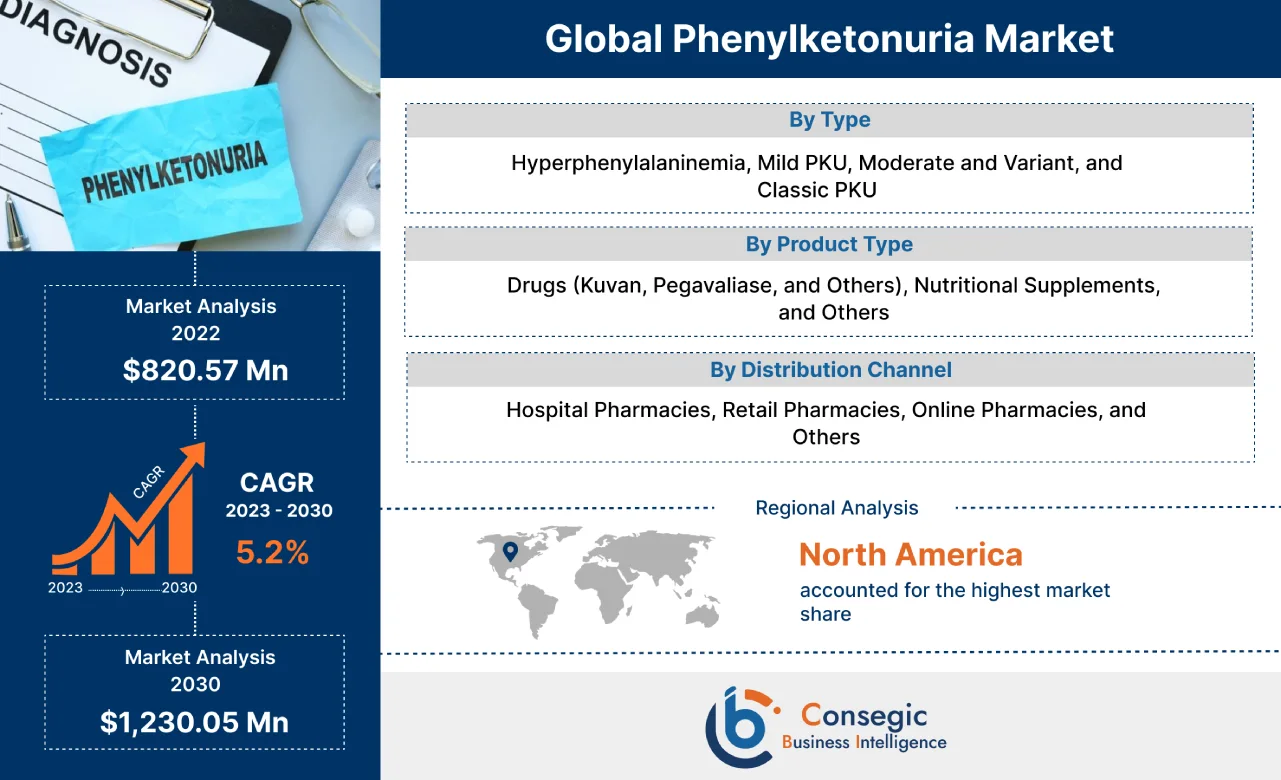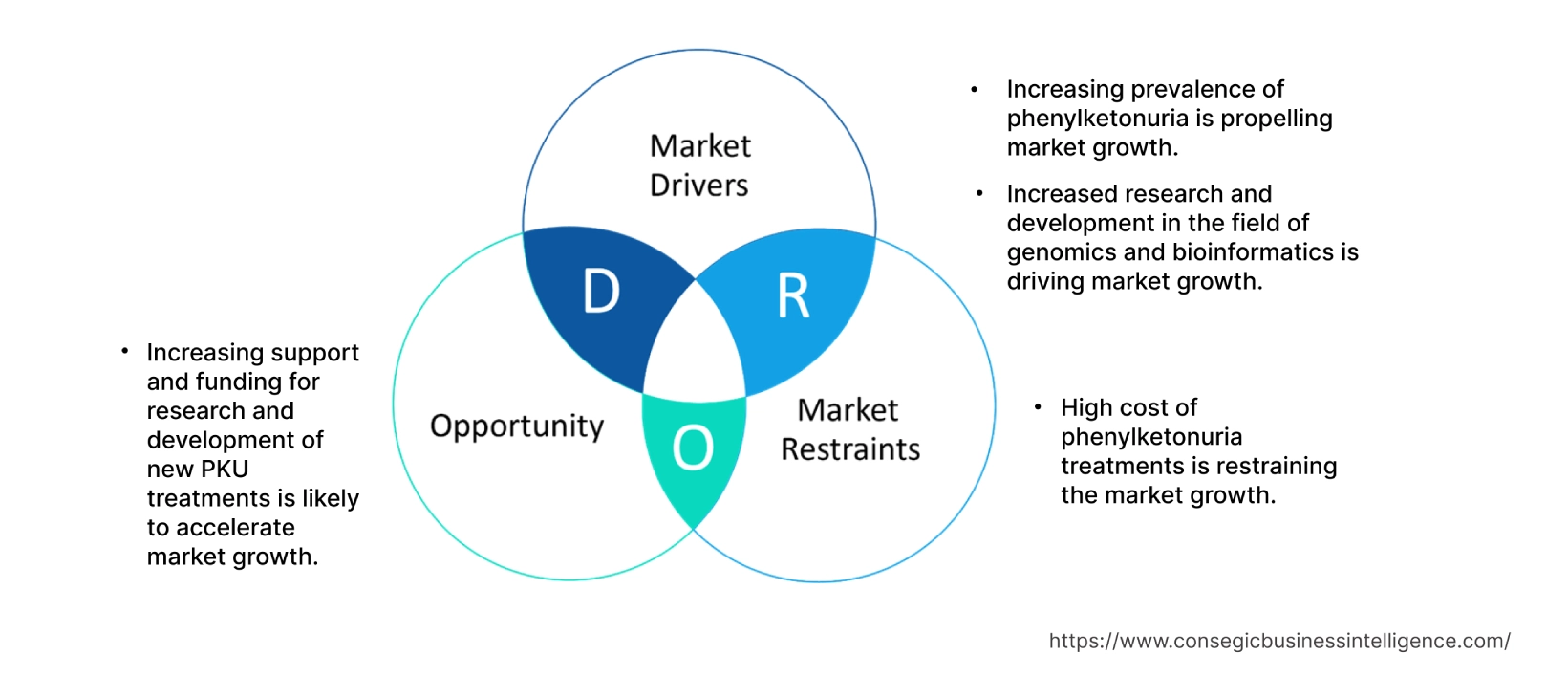Phenylketonuria Market Size :
Consegic Business Intelligence analyzes that the phenylketonuria market size is growing with a CAGR of 5.2% during the forecast period (2023-2030), and the market is projected to be valued at 1,230.05 Million by 2030 from 820.57 Million in 2022.
Phenylketonuria Market Scope & Overview:
Phenylketonuria, also known as PKU, is a rare genetically inherited disorder. This disease leads to an increased amount of amino acid called phenylalanine in the blood, resulting in the buildup of toxic levels of amino acid in the blood and brain tissues. It is caused by a change in the phenylalanine hydroxylase (PAH) gene. This gene helps create the enzyme needed to break down phenylalanine. Based on the analysis, a person diagnosed with this condition shows mild to severe symptoms of skin rashes such as eczema, neurological problems, musty odor in breath, skin or urine, lighter skin, hair and eye color, intellectual disability, and others. It is treated by lowering the consumption of food with phenylalanine and taking special nutritional supplements to get essential proteins without phenylalanine.
Phenylketonuria Market Insights :
Phenylketonuria Market Dynamics - (DRO) :
Key Drivers :
Increasing prevalence of phenylketonuria is propelling market growth
Phenylketonuria is a rare inherited genetic disorder that elevates the amount of phenylalanine in the human body. The human body breaks down the protein from food such as meat, fish, and eggs into amino acids which are further used in various applications in the human body. Any amino acid that is not required by the body is broken down and removed from the body. A person diagnosed with this condition cannot break down the excessive amino acid in the body which then builds up in blood and the brain. Resulting in brain damage. According to the report by the National Health Service of the U.K., 1 in 10,000 babies in the U.K. is diagnosed with this condition. Furthermore, according to a study conducted by healthcare students at the Selected Public University in Klang Valley, Malaysia, phenylketonuria was identified as the top three most common inborn metabolic diseases. Based on the analysis, the increasing prevalence of this condition across various countries worldwide is driving market trends. For instance, according to the report by the National Center for Biotechnology Information in July 2020, globally 0.45 million individuals have been diagnosed with this condition, with a global prevalence of 1:23,930 live births.
Increased research and development in the field of genomics and bioinformatics is driving market demand
Genomics is the study of genetics or epigenetic sequence information of organisms. Bioinformatics is also related to the study of genetics and genomes, where it uses computer technology to collect, store, analyze, and disseminate biological data and information, such as DNA and amino acid sequences. These technologies are used to analyze data from genome sequencing. Genomics and bioinformatics both technologies play a very important role in tracking diseased genes in the disorder which can be further targeted to find the right treatment for the disease. Based on the analysis, increasing investment in bioinformatics and genomics for the development of the healthcare system and understanding diseases and allergies is driving market trends. For instance, in October 2021, the Government of the U.K. announced an investment of USD 6.37 billion to increase health-related research and development activities across the U.K. As a part of this initiative, Genomics England receives funding to support initiatives, such as ‘Generation Genome,' which is a study conducted to track genome sequencing to detect rare diseases among newborn babies. Hence, the rising investments in the field of genomics and bioinformatics are boosting the research and development activities in disease management, and further driving the phenylketonuria market trends.
Key Restraints :
High cost of phenylketonuria treatments is restraining the market demand
Phenylketonuria is a genetic disorder that leads to the improper function of amino acids in the human body. People diagnosed with this condition have a deficiency of phenylalanine which helps to break down amino acids in the human body. Various treatments such as limiting food intake with phenylalanine, taking nutritional supplements to get essential proteins, and taking medications or drugs are used to limit the effects of this condition in the human body. However, based on the analysis, the expenses associated with specialized medical foods, prescription medications, and regular monitoring create financial burdens for the patients and their families. This limits the accessibility to effective treatment options, especially in regions with limited healthcare resources. As a result, the potential market for the treatment of this condition remains limited. Therefore, the aforementioned factors are hampering the phenylketonuria market growth.
Future Opportunities :
Increasing support and funding for research and development of new treatments is likely to accelerate market trends
The phenylketonuria market has witnessed significant advancements in recent years, owing to the increasing research and development activities for the development of treatments. These significant trends in research and development activities have led to the development of advanced drug treatments and supplements to lower the effects of the conditions among patients and expand their life expectancy. For instance, in November 2022, Jnana Therapeutics, a biotechnology company, announced that it has raised USD 107 million along with a partnership with Roche for the discovery of small molecule drugs for the treatment of cancer, immune-mediated and neurological diseases. Based on the analysis, the funds will be used to advance Jnana's lead program in proof-of-concept clinical trials for the treatment of this condition. Furthermore, in November 2020, Pfizer announced an investment of USD 60 million in Homology, which is a genetic medicine company for the development of Homology's HMI-102 gene therapy used for the treatment of this condition. Such increasing investment in the development of new therapies and treatments for this condition is expected to provide lucrative phenylketonuria market opportunities over the forecast period.
Phenylketonuria Market Report Insights :
| Report Attributes | Report Details |
| Study Timeline | 2017-2030 |
| Market Size in 2030 | USD 1,230.05 Million |
| CAGR (2023-2030) | 5.2% |
| By Type | Hyperphenylalaninemia, Mild PKU, Moderate and Variant, and Classic PKU |
| By Product Type | Drugs (Kuvan, Pegavaliase, and Others), Nutritional Supplements, and Others |
| By Distribution Channel | Hospital Pharmacies, Retail Pharmacies, Online Pharmacies, and Others |
| By Region | North America, Europe, Asia-Pacific, Latin America, and Middle East & Africa |
| Key Players | Cambrooke Therapeutics, American Gene Technologies International, Inc., BioMarin Pharmaceutical, Inc., PTC Therapeutics, Relief Therapeutics Holding SA, Codexis, Inc., Agios Pharmaceuticals Inc, Castle Crek Biosciences, Inc., Synlogic, Pristine Organics, and Galen Pharma |
Phenylketonuria Market Segmental Analysis :
By Type :
The type segment is categorized into hyperphenylalaninemia, mild PKU, moderate and variant, and classic PKU. In 2022, the classic PKU segment accounted for the highest phenylketonuria market share of 37.53% in the overall phenylketonuria market. Classic PKU is the most common and severe type of this condition. Infants suffering from classic develop permanent intellectual disability. Untreated individuals may have a musty or mouse-like odor as a side effect of excess phenylalanine in the body. As per the analysis, children with classic PKU tend to have lighter skin and hair than unaffected family members and are also likely to have skin disorders such as eczema. The high severity of classic PKU is driving segment trends across the globe.
However, the hyperphenylalaninemia segment is expected to grow at the fastest CAGR in the market during the forecast period. The trends of the segment is attributed to the increasing availability of medications for the treatment of this disorder. For instance, in May 2021, the European Medication Agency announced the launch of orphan medicines for the treatment of hyperphenylalaninemia in the Europe region. Hence, the launch of new medicines by market government bodies will further foster phenylketonuria market demand over the forecast period.
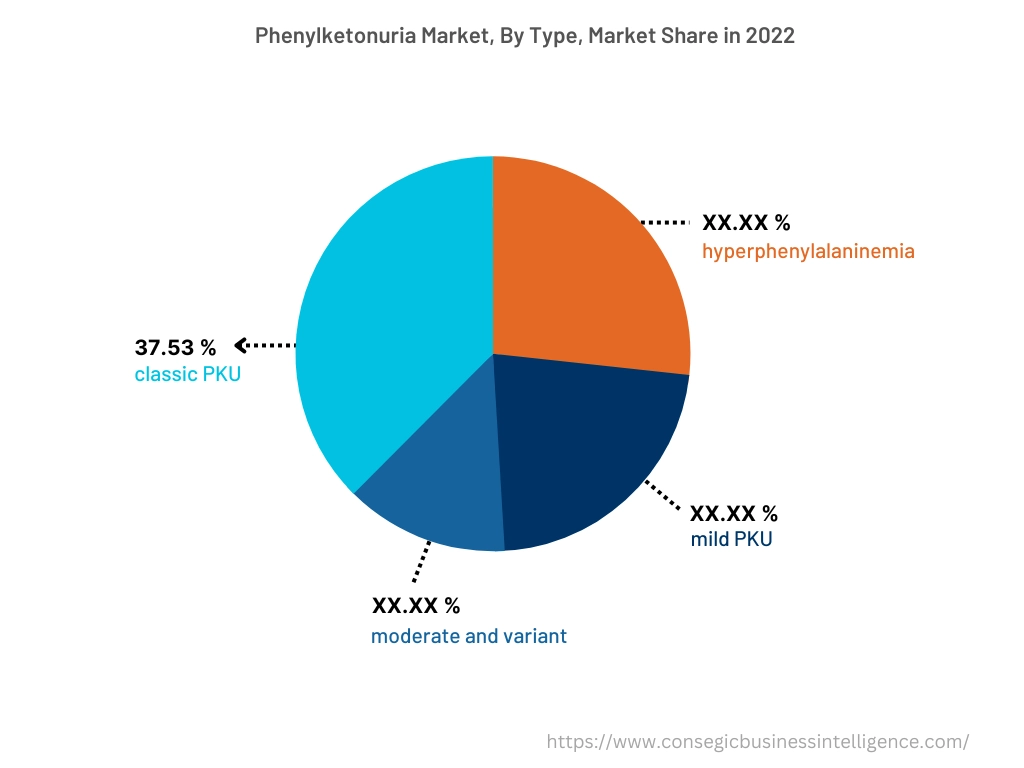
By Product Type :
The product segment is categorized into drugs, nutritional supplements, and others. In 2022, the nutritional supplements segment accounted for the highest market share in the overall phenylketonuria market and is expected to grow at the fastest CAGR over the forecast period. Nutritional supplements are easy to consume in comparison with other product types. Nutritional supplements are available in various forms such as powder, liquid, tablets, capsules, and others. These supplements can be easily consumed along with food, smoothies, shakes, and other forms. Moreover, these nutritional supplements have a moderate concentration of the essential components required for the treatment of this condition, due to which it show lower side effects as compared to other product types. As a result, the above benefits lead to an increased demand for nutritional supplements for the treatment of this condition, in turn, propelling the industry demand in the following years.
By Distribution Channel :
The distribution channel segment is categorized into hospital pharmacies, retail pharmacies, online pharmacies, and others. In 2022, the hospital pharmacies segment accounted for the highest market share in the overall phenylketonuria market and is also expected to grow at the fastest CAGR in the market during the forecast period. The drugs and supplements required for the treatment of this condition are rarely available in pharmaceutical stores due to the lower rarity of the disease and the lesser availability of effects medications in the market. Hospital pharmacies are the prominent distribution channels that are equipped to provide a comprehensive range of medicines, drugs, and supplements for this treatment. Additionally, hospitals have all the necessary infrastructure which is required to handle the storage, dispensing, and administration of specialized medications and formulas. Furthermore, hospital pharmacies have all the required regulatory documentation required for handling the drugs and supplements used for the treatment of this condition and they also have an established connection with the pharmaceutical companies, enabling the efficient procurement and distribution of the medicines. Such factors are driving the growth of hospital pharmacies among the distribution channel segment and are also expected to further drive the segment growth during the forecast period.
By Region :
The regional segment includes North America, Europe, Asia Pacific, the Middle East and Africa, and Latin America.
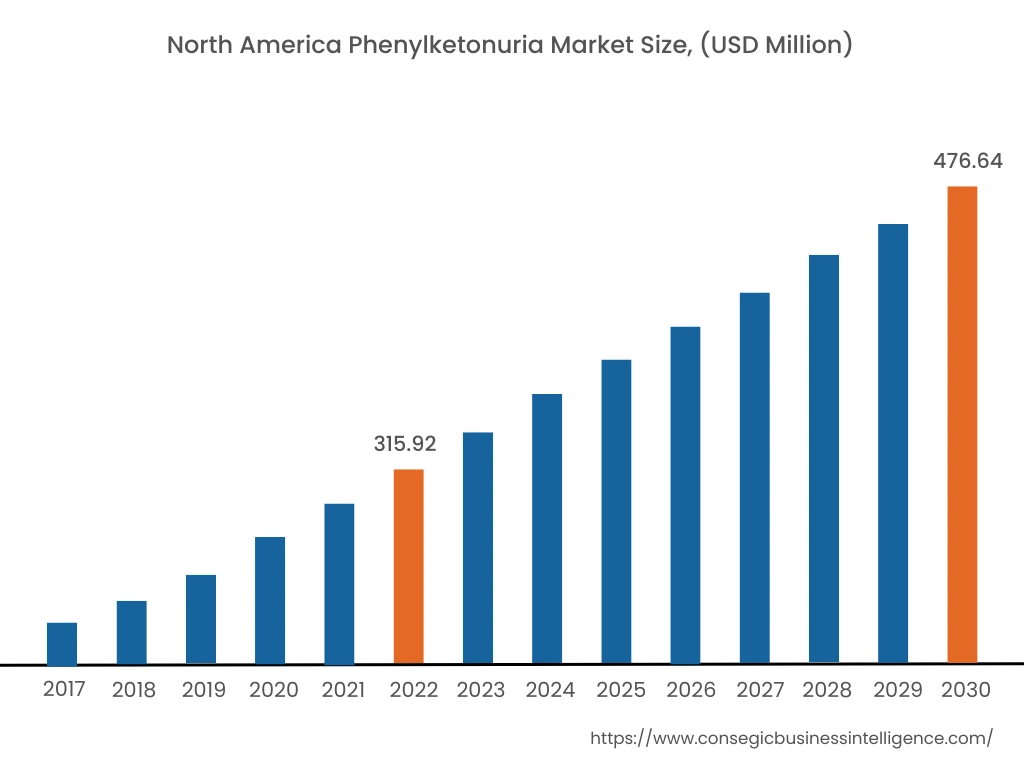
In 2022, North America accounted for the highest market share of 38.50% and was valued at USD 315.92 million and is expected to reach USD 476.64 million in 2030. In the North America region, the U.S. accounted for the highest market share of 72.05% during the base year 2022 owing to the higher number of people diagnosed with this condition and rising government initiatives for the treatment of this condition across the region. For instance, according to the report by National PKU Alliance, the estimated number of people diagnosed with this condition in the U.S. accounted for 16,500 people. Moreover, the increasing launch of new and advanced drug therapies and medications across the region is also driving the growth of the phenylketonuria market. For instance, in October 2022, Cycle Pharmaceuticals Limited announced the launch of JAVYGTOR (sapropterin dihydrochloride) tablets for oral use and powder for oral solution, as a treatment option for patients with this condition. Based on the global phenylketonuria market analysis, these medications are approved by the US Food and Drug Administration (FDA). Thus, increasing new product launches and the high prevalence of this condition in North America are driving the phenylketonuria market growth.
Moreover, Europe is expected to grow at the fastest CAGR of 5.9% during the forecast period due to the growing frequency of this disease across European countries. According to the report by the National Institute of Health, in Europe the prevalence of the condition is nearly around 1 in 10,000 newborns, with the highest rate in Ireland and Turkey.
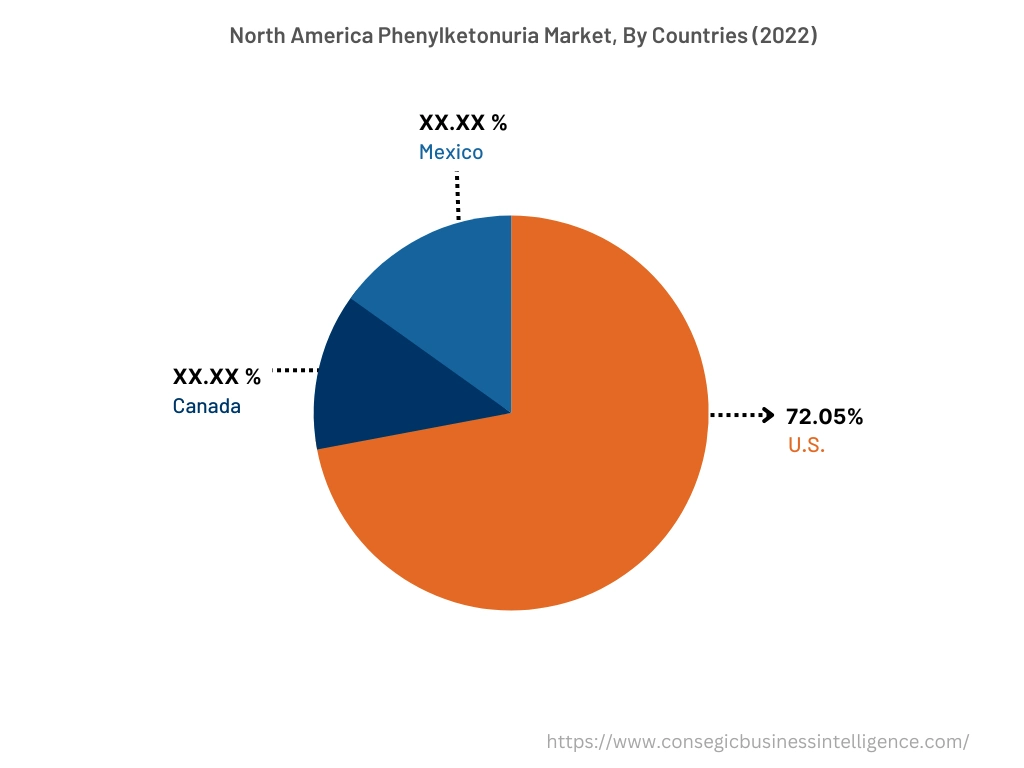
Top Key Players & Market Share Insights:
The Phenylketonuria Market is highly competitive, with several large players and numerous small and medium-sized enterprises. These companies have strong research and development capabilities and a strong presence in the market through their extensive product portfolios and distribution networks. The market is characterized by intense competition, with companies focusing on expanding their product offerings and increasing their market share through mergers, acquisitions, and partnerships. The key players in the phenylketonuria industry include-
- Cambrooke Therapeutics
- American Gene Technologies International, Inc.
- Castle Crek Biosciences, Inc.
- Synlogic
- Pristine Organics
- Galen Pharma
- BioMarin Pharmaceutical, Inc.
- PTC Therapeutics
- Relief Therapeutics Holding SA
- Codexis, Inc.
- Agios Pharmaceuticals Inc
Recent Industry Developments :
- In October 2022, Relief Therapeutics Holding SA, a Switzerland-based biopharmaceutical company announced the launch of PKU GOLIKE, which is a medical food product for dietary management of this condition.
- In October 2020, BioMarin Pharmaceutical Inc., announced that the U.S. Food and Drug Administration (FDA) has approved the supplemental biologics license application to increase the maximum allowable dose of 60 mg with Palynziq injection for the treatment of adults with PKU.
- In February 2020, Galen Pharma announced the launch of an innovative medical food for the treatment of PKU.
Key Questions Answered in the Report
What was the market size of the phenylketonuria market in 2022? +
In 2022, the market size of Phenylketonuria was USD 820.57 million
What will be the potential market valuation for the phenylketonuria market by 2030? +
In 2030, the market size of phenylketonuria will be expected to reach USD 1,230.05 million.
What are the key factors driving the growth of the phenylketonuria market? +
Increasing prevalence of phenylketonuria is propelling the market growth.
What is the dominating segment in the phenylketonuria market by product type? +
In 2022, the classic PKU segment accounted for the highest market share of 37.53% in the overall phenylketonuria market.
Based on current market trends and future predictions, which geographical region will have the fastest impact on the phenylketonuria market's growth in the coming years? +
Europe is expected to be the fastest-growing region in the market during the forecast period.
